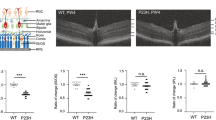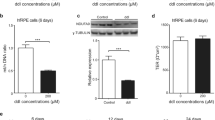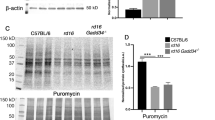Abstract
Absorption of a light particle by an opsin-pigment causes photoisomerization of its retinaldehyde chromophore. Restoration of light sensitivity to the resulting apo-opsin requires chemical re-isomerization of the photobleached chromophore. This is carried out by a multistep enzyme pathway called the visual cycle. Accumulating evidence suggests the existence of an alternative visual cycle for regenerating opsins in daylight. Here we identified dihydroceramide desaturase-1 (DES1) as a retinol isomerase and an excellent candidate for isomerase-2 in this alternative pathway. DES1 is expressed in retinal Müller cells, where it coimmunoprecipitates with cellular retinaldehyde binding protein (CRALBP). Adenoviral gene therapy with DES1 partially rescued the biochemical and physiological phenotypes in Rpe65−/− mice lacking isomerohydrolase (isomerase-1). Knockdown of DES1 expression by RNA interference concordantly reduced isomerase-2 activity in cultured Müller cells. Purified DES1 had very high isomerase-2 activity in the presence of appropriate cofactors, suggesting that DES1 by itself is sufficient for isomerase activity.
This is a preview of subscription content, access via your institution
Access options
Subscribe to this journal
Receive 12 print issues and online access
$259.00 per year
only $21.58 per issue
Buy this article
- Purchase on Springer Link
- Instant access to full article PDF
Prices may be subject to local taxes which are calculated during checkout






Similar content being viewed by others
Accession codes
References
Crouch, R., Purvin, V., Nakanishi, K. & Ebrey, T. Isorhodopsin II: artificial photosensitive pigment formed from 9,13-dicis retinal. Proc. Natl. Acad. Sci. USA 72, 1538–1542 (1975).
Jin, M., Li, S., Moghrabi, W.N., Sun, H. & Travis, G.H. Rpe65 is the retinoid isomerase in bovine retinal pigment epithelium. Cell 122, 449–459 (2005).
Redmond, T.M. et al. Mutation of key residues of RPE65 abolishes its enzymatic role as isomerohydrolase in the visual cycle. Proc. Natl. Acad. Sci. USA 102, 13658–13663 (2005).
Goldstein, E.B. Cone pigment regeneration in the isolated frog retina. Vision Res. 10, 1065–1068 (1970).
Hood, D.C. & Hock, P.A. Recovery of cone receptor activity in the frog's isolated retina. Vision Res. 13, 1943–1951 (1973).
Jones, G.J., Crouch, R.K., Wiggert, B., Cornwall, M.C. & Chader, G.J. Retinoid requirements for recovery of sensitivity after visual-pigment bleaching in isolated photoreceptors. Proc. Natl. Acad. Sci. USA 86, 9606–9610 (1989).
Wang, J.S., Estevez, M.E., Cornwall, M.C. & Kefalov, V.J. Intra-retinal visual cycle required for rapid and complete cone dark adaptation. Nat. Neurosci. 12, 295–302 (2009).
Wang, J.S. & Kefalov, V.J. An alternative pathway mediates the mouse and human cone visual cycle. Curr. Biol. 19, 1665–1669 (2009).
Das, S.R., Bhardwaj, N., Kjeldbye, H. & Gouras, P. Muller cells of chicken retina synthesize 11-cis-retinol. Biochem. J. 285, 907–913 (1992).
Bunt-Milam, A.H. & Saari, J.C. Immunocytochemical localization of two retinoid-binding proteins in vertebrate retina. J. Cell Biol. 97, 703–712 (1983).
Eisenfeld, A.J., Bunt-Milam, A.H. & Saari, J.C. Localization of retinoid-binding proteins in developing rat retina. Exp. Eye Res. 41, 299–304 (1985).
Wu, B.X. et al. Identification of RDH10, an all-trans retinol dehydrogenase, in retinal Muller cells. Invest. Ophthalmol. Vis. Sci. 45, 3857–3862 (2004).
Mata, N.L., Radu, R.A., Clemmons, R. & Travis, G.H. Isomerization and oxidation of vitamin a in cone-dominant retinas. A novel pathway for visual-pigment regeneration in daylight. Neuron 36, 69–80 (2002).
Mata, N.L., Ruiz, A., Radu, R.A., Bui, T.V. & Travis, G.H. Chicken retinas contain a retinoid isomerase activity that catalyzes the direct conversion of all-trans-retinol to 11-cis-retinol. Biochemistry 44, 11715–11721 (2005).
Muniz, A. et al. Evidence for two retinoid cycles in the cone-dominated chicken eye. Biochemistry 48, 6854–6863 (2009).
Moiseyev, G., Chen, Y., Takahashi, Y., Wu, B.X. & Ma, J.X. RPE65 is the isomerohydrolase in the retinoid visual cycle. Proc. Natl. Acad. Sci. USA 102, 12413–12418 (2005).
Cadena, D.L., Kurten, R.C. & Gill, G.N. The product of the MLD gene is a member of the membrane fatty acid desaturase family: overexpression of MLD inhibits EGF receptor biosynthesis. Biochemistry 36, 6960–6967 (1997).
Savile, C.K., Fabrias, G. & Buist, P.H. Dihydroceramide δ4 ddesaturase initiates substrate oxidation at C-4. J. Am. Chem. Soc. 123, 4382–4385 (2001).
Shanklin, J., Whittle, E. & Fox, B.G. Eight histidine residues are catalytically essential in a membrane-associated iron enzyme, stearoyl-CoA desaturase, and are conserved in alkane hydroxylase and xylene monooxygenase. Biochemistry 33, 12787–12794 (1994).
Michel, C. et al. Characterization of ceramide synthesis. A dihydroceramide desaturase introduces the 4,5-trans-double bond of sphingosine at the level of dihydroceramide. J. Biol. Chem. 272, 22432–22437 (1997).
Rioux, V., Pedrono, F. & Legrand, P. Regulation of mammalian desaturases by myristic acid: N-terminal myristoylation and other modulations. Biochim. Biophys. Acta 1811, 1–8 (2011).
Beauchamp, E. et al. N-Myristoylation targets dihydroceramide δ4-desaturase 1 to mitochondria: partial involvement in the apoptotic effect of myristic acid. Biochimie 91, 1411–1419 (2009).
Causeret, C., Geeraert, L., Van der Hoeven, G., Mannaerts, G.P. & Van Veldhoven, P.P. Further characterization of rat dihydroceramide desaturase: tissue distribution, subcellular localization, and substrate specificity. Lipids 35, 1117–1125 (2000).
Beauchamp, E. et al. Myristic acid increases the activity of dihydroceramide δ4-desaturase 1 through its N-terminal myristoylation. Biochimie 89, 1553–1561 (2007).
Triola, G., Fabrias, G., Casas, J. & Llebaria, A. Synthesis of cyclopropene analogues of ceramide and their effect on dihydroceramide desaturase. J. Org. Chem. 68, 9924–9932 (2003).
Rahmaniyan, M., Curley, R.W. Jr., Obeid, L.M., Hannun, Y.A. & Kraveka, J.M. Identification of dihydroceramide desaturase as a direct in vitro target for fenretinide. J. Biol. Chem. 286, 24754–24764 (2011).
Rando, R.R. & Chang, A. Studies on the catalyzed interconversion of vitamin A derivatives. J. Am. Chem. Soc. 105, 2879–2882 (1983).
Rando, R.R. Molecular mechanisms in visual pigment regeneration. Photochem. Photobiol. 56, 1145–1156 (1992).
Redmond, T.M., Poliakov, E., Kuo, S., Chander, P. & Gentleman, S. RPE65, visual cycle retinol isomerase, is not inherently 11-cis-specific: support for a carbocation mechanism of retinol isomerization. J. Biol. Chem. 285, 1919–1927 (2010).
Trevino, S.G., Villazana-Espinoza, E.T., Muniz, A. & Tsin, A.T. Retinoid cycles in the cone-dominated chicken retina. J. Exp. Biol. 208, 4151–4157 (2005).
Kefalov, V.J. et al. Breaking the covalent bond—a pigment property that contributes to desensitization in cones. Neuron 46, 879–890 (2005).
Redmond, T.M. et al. Rpe65 is necessary for production of 11-cis-vitamin A in the retinal visual cycle. Nat. Genet. 20, 344–351 (1998).
Znoiko, S.L. et al. Downregulation of cone-specific gene expression and degeneration of cone photoreceptors in the Rpe65−/− mouse at early ages. Invest. Ophthalmol. Vis. Sci. 46, 1473–1479 (2005).
Di Polo, A., Aigner, L.J., Dunn, R.J., Bray, G.M. & Aguayo, A.J. Prolonged delivery of brain-derived neurotrophic factor by adenovirus-infected Muller cells temporarily rescues injured retinal ganglion cells. Proc. Natl. Acad. Sci. USA 95, 3978–3983 (1998).
Saari, J.C. & Bredberg, D.L. Photochemistry and stereoselectivity of cellular retinaldehyde-binding protein from bovine retina. J. Biol. Chem. 262, 7618–7622 (1987).
Golovleva, I. et al. Disease-causing mutations in the cellular retinaldehyde binding protein tighten and abolish ligand interactions. J. Biol. Chem. 278, 12397–12402 (2003).
Saari, J.C., Nawrot, M., Stenkamp, R.E., Teller, D.C. & Garwin, G.G. Release of 11-cis-retinal from cellular retinaldehyde-binding protein by acidic lipids. Mol. Vis. 15, 844–854 (2009).
Hubbard, R. The thermal stability of rhodopsin and opsin. J. Gen. Physiol. 42, 259–280 (1958).
Meyer, D.B. & May, H.C. Jr. The topographical distribution of rods and cones in the adult chicken retina. Exp. Eye Res. 17, 347–355 (1973).
Carter-Dawson, L.D. & LaVail, M.M. Rods and cones in the mouse retina. I. Structural analysis using light and electron microscopy. J. Comp. Neurol. 188, 245–262 (1979).
Rohrer, B. et al. Correlation of regenerable opsin with rod ERG signal in Rpe65−/− mice during development and aging. Invest. Ophthalmol. Vis. Sci. 44, 310–315 (2003).
Caruso, R.C. et al. Retinal disease in Rpe65-deficient mice: comparison to human Leber congenital amaurosis due to RPE65 mutations. Invest. Ophthalmol. Vis. Sci. 51, 5304–5313 (2010).
Fan, J., Rohrer, B., Moiseyev, G., Ma, J.X. & Crouch, R.K. Isorhodopsin rather than rhodopsin mediates rod function in RPE65 knock-out mice. Proc. Natl. Acad. Sci. USA 100, 13662–13667 (2003).
Farjo, K.M., Moiseyev, G., Takahashi, Y., Crouch, R.K. & Ma, J.X. The 11-cis-retinol dehydrogenase activity of RDH10 and its interaction with visual cycle proteins. Invest. Ophthalmol. Vis. Sci. 50, 5089–5097 (2009).
Baylor, D.A., Nunn, B.J. & Schnapf, J.L. The photocurrent, noise and spectral sensitivity of rods of the monkey Macaca fascicularis. J. Physiol. (Lond.) 357, 575–607 (1984).
Hsu, S.C. & Molday, R.S. Glucose metabolism in photoreceptor outer segments. Its role in phototransduction and in NADPH-requiring reactions. J. Biol. Chem. 269, 17954–17959 (1994).
Radu, R.A. et al. Reductions in serum vitamin a arrest accumulation of toxic retinal fluorophores: a potential therapy for treatment of lipofuscin-based retinal diseases. Invest. Ophthalmol. Vis. Sci. 46, 4393–4401 (2005).
Nusinowitz, S., Ridder, W.H. III & Ramirez, J. Temporal response properties of the primary and secondary rod-signaling pathways in normal and Gnat2 mutant mice. Exp. Eye Res. 84, 1104–1114 (2007).
Acknowledgements
We thank R. Radu for insightful suggestions throughout this project and valuable comments on the manuscript, J. Hu and D. Bok for assistance with immunocytochemistry, M. Redmond (National Eye Institute) for providing Rpe65−/− mice, and R. Crouch (Medical University of South Carolina) for the gift of 11-cis-RAL. This work was supported by a grant to G.H.T. from the US National Eye Institute (R01-EY11713). G.H.T. is the Charles Kenneth Feldman Professor of Ophthalmology.
Author information
Authors and Affiliations
Contributions
G.H.T. conceived the project. G.H.T., J.J.K., C.N.R., Q.Y. and S.N. designed the experiments and interpreted the data. J.J.K., Q.Y., J.C., S.S., J.M., A.M., A.K., P.K., S.H., T.X. and C.N.R. performed the experiments. G.H.T. wrote the manuscript.
Corresponding author
Ethics declarations
Competing interests
The authors declare no competing financial interests.
Supplementary information
Supplementary Text and Figures
Supplementary Results and Supplementary Methods (PDF 1465 kb)
Rights and permissions
About this article
Cite this article
Kaylor, J., Yuan, Q., Cook, J. et al. Identification of DES1 as a vitamin A isomerase in Müller glial cells of the retina. Nat Chem Biol 9, 30–36 (2013). https://doi.org/10.1038/nchembio.1114
Received:
Accepted:
Published:
Issue Date:
DOI: https://doi.org/10.1038/nchembio.1114
This article is cited by
-
Non-visual Opsins and Novel Photo-Detectors in the Vertebrate Inner Retina Mediate Light Responses Within the Blue Spectrum Region
Cellular and Molecular Neurobiology (2022)
-
Restoration of high-sensitivity and adapting vision with a cone opsin
Nature Communications (2019)
-
ADIPOR1 is essential for vision and its RPE expression is lost in the Mfrprd6 mouse
Scientific Reports (2018)
-
Blue light regenerates functional visual pigments in mammals through a retinyl-phospholipid intermediate
Nature Communications (2017)
-
The role of retinol dehydrogenase 10 in the cone visual cycle
Scientific Reports (2017)



